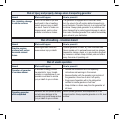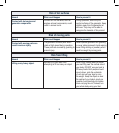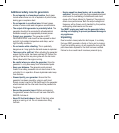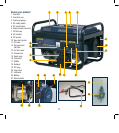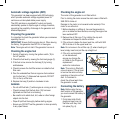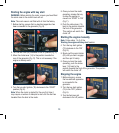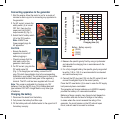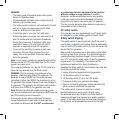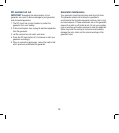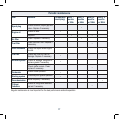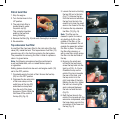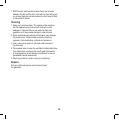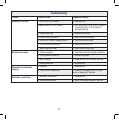
15
WARNING.
• The battery gives off explosive gases; keep sparks,
flames and cigarettes away.
• Provide adequate ventilation when charging or using
batteries in an enclosed space.
• The battery contains sulphuric acid (electrolyte). Contact
with skin or eyes may cause severe burns. Wear
protective clothing and a face shield.
• If electrolyte gets on your skin, flush with water.
• If electrolyte gets in your eyes, flush with water for at
least 15 minutes and call a physician immediately.
• Electrolyte is poisonous. If swallowed, drink large
quantities of water or milk and follow with milk of
magnesia or vegetable oil and call a physician.
• To prevent the possibility of creating a spark near
the battery, connect charging cables first to the
battery, then to the generator. Disconnect cables
first at the generator.
Note. In most cases, operating the generator with both the
240Vac and the 12V DC at the same time, the DC Circuit
breaker may open circuit.
When charging batteries, only use the 12V DC outlet and
leave the plug removed from the 240Vac outlet.
WARNING. Prior to connecting any appliance to the
generator, check the rating label of the appliance. The
generator is rated at 2000W so if the appliance being
connected is higher than 2000W, the protective cut out on
the generator may operate to prevent over load damage to
the generator. The generator will withstand short operation
and spikes up to 2300W or the generator may stop.
Note. Motorised products will require more energy upon
start up and products which are rated below 2000W may not
start if the starting current is excessive.
It should also be very clearly understood that output
voltage fluctuations will occur when various loads are
connected and disconnected. It is NOT recommended
to connect any electronic equipment to the generator
without a voltage or surge protector. Computers,
televisions, and stereo equipment can be very sensitive
to the input supply and could be damaged if protective
equipment is not used in conjunction with this generator.
This also includes caravans where electronic equipment is
incorporated as part of the wiring.
AC safety switch
This generator has been equipped with an AC safety switch
(4), designed to protect people against an electric shock.
Safety switch tripping
If the safety switch (4) has tripped and cuts off the power, it
may be due to substantial overloading. Marginal overloading
may not switch off the safety switch (4), but it will shorten the
service life of the generator.
Be sure that all appliances are in good working order before
connecting them to the generator. If an appliance begins to
operate abnormally, becomes sluggish, or stops suddenly,
turn “OFF” both the AC safety switch (4) and the generator
engine switch (10) immediately. Then disconnect the
appliance and examine it for signs of malfunction.
Resetting the safety switch (4) should restore the power and
should be conducted as follows:
1. Unplug all electrical apparatus from the generator.
2. Let the safety switch (4) cool down.
3. Lift the safety switch (4) up to the “ON” position.
4. Commence to start your generator accordingly.
5. When re connecting appliances, reduce the load to that
which previously overloaded the generator.
If the safety switch (4) does not reset due to a faulty
electrical appliance or wiring, switch off and unplug
the appliance which may be faulty. Any faulty electrical
appliances will need to be repaired by a suitably qualified
person. If the safety switch does not reset after unplugging
the appliance, call a licensed electrician to find the fault.




